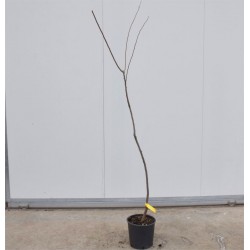Lemon tree Red caviar, Vase7
Generalities:
The caviar lemon comes from Australia and its cultivation is possible even with our soil and climate. Caviar lemons are appreciated for their characteristic pulp which, in fact, resembles caviar: it is made up of numerous and small translucent and crunchy vesicles with a rounded / oval shape. The color of the vegetable caviar of the Citrus Faustrime and Citrus australasica species ranges from a more lively pink to a straw yellow.
- Vase 7cm, Height 10-15cm
Generalities:
Citrus australasica, also known as Australian Finger Lime or simply Finger lime, is a citrus fruit with a grainy pulp that grows well in our climate and which, due to the consistency and shape of its pulp, was soon renamed lemon caviar. or vegetable caviar. As the botanical name suggests, citrus australasica is a plant native to Australia, it grows spontaneously in the subtropical areas and in the rainforest of the regions bordering Queensland and New South Wales. Unlike lemons and other plants of the citrus genus to which we are accustomed, finger lime grows shrubby, so much so that according to the Swingle taxonomic system, it is not part of the citrus genus but in a related genus of "Microcitrus". Its edible fruits are attracting a lot of attention. The cultivation of Citrus Australasica can give great satisfaction and not only for the production of vegetable caviar: Citrus australasica blooms 2-3 times a year starting from March. The flowers are not particularly delicate even if the appearance can be deceiving: they have three small petals, white in color mottled with pale pink. The flowers seem very delicate and measure only 0.8 cm, unlike the flowers of other citrus fruits, those of citrus australasica have an almost imperceptible fragrance. The fruits produced by the citrus Australasica vaguely resemble fingers (which is why the plant was renamed finger Lime) and are reddish-brown in color. The grainy pulp (vegetable caviar) is a light coppery pink color. The fruits have an elongated shape and develop up to 4 - 8 cm in length and 2.5 cm in diameter. They have a thin and wrinkled skin with a color that, like the pulp, varies slightly according to the cultivation.
Cultivation and Care:
As stated, growing the citrus Australasica is easy both in pots and in the garden. The cultivation of Citrus Australasica is "obligatory" in pots for those who live in the Center-North: Citrus Australasica resists only light frosts so it is not suitable for outdoor cultivation. Those who live in central and northern Italy will have to repair the Citrus australasica in the winter months, moving it to an indoor and well-lit room. During flowering it will be necessary to provide constant irrigation. It is at this time of the year (from March) that it will be necessary to administer potassium-based fertilizer to facilitate fruit production.In view of the autumn, it is good to provide fertilization with potassium sulphate both to help the plant to resist the cold, both to allow the plants to stock up on this element in view of the next flowering.

























